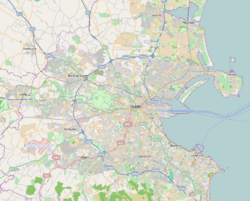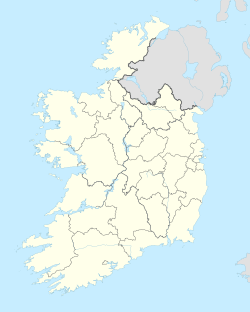St. Wolstan's Priory facts for kids
| Prióireacht San Ualstain | |
| Monastery information | |
|---|---|
| Other names | Scala Caeli |
| Order | Victorines |
| Established | 1202/05 |
| Mother house | Abbey of Saint-Victor, Paris |
| Diocese | Dublin |
| People | |
| Founder(s) | Adam de Hereford |
| Architecture | |
| Status | ruined |
| Style | Norman |
| Site | |
| Location | St. Wolstan's, Celbridge, County Kildare |
| Coordinates | 53°20′37″N 6°31′02″W / 53.343605°N 6.517151°W |
| Visible remains | two gateways, tower |
| Public access | No |
St. Wolstan's Priory was once an important religious building in County Kildare, Ireland. It was a type of monastery, a place where a group of religious people called Augustinian canons lived and prayed. They belonged to a special group known as the Victorines, linked to the Abbey of Saint-Victor in Paris. Today, only ruins remain, but they tell a fascinating story of Irish history.
Contents
Where is St. Wolstan's Priory?
St. Wolstan's Priory is located on the eastern edge of a town called Celbridge. It sits on the south bank of the River Liffey. The priory is about 1 kilometer southeast of Castletown House and around 1.8 kilometers east-northeast of Celbridge's main street.
The Priory's Beginnings
The priory was founded between 1202 and 1205. It was started by Adam de Hereford, who was one of the Anglo-Norman leaders. These leaders came to Ireland during the Norman conquest of Ireland. The priory was built for canons from the order of St. Victor. It was named after Saint Wulfstan, a holy man who had recently become a saint. The first buildings were even called Scala Coeli, which means "stairs of heaven."
Growing in Importance
Over time, the priory received more land and power. In 1271, a man named William de Mandesham gave the priory lands in an area called Tristildelane. This area is known today as Castledillon.
In 1308, a bridge was built across the River Liffey right next to the priory's gate. This bridge was built by John Ledleer. Later, in 1314, the priory was given control of the churches of Stacumney and Donaghmore. This meant the prior, or head of the monastery, could use these churches for the priory's own needs.
The End of the Priory
King Henry VIII's Actions
A big change happened in 1536. King Henry VIII of England decided to close many monasteries. This event is known as the Dissolution of the Monasteries. St. Wolstan's Priory was the very first monastery in Ireland to be closed down by the King.
The last prior, Richard Weston, was allowed to stay. He was given a room in the monastery and received food and fuel for the rest of his life. In 1538, the priory and its lands were given to a man named John Alan.
From Monastery to Home
The priory buildings were likely changed into a house for Sir John Alan. He lived there until he passed away in 1561. The Alen family lived at St. Wolstan's for a very long time, 216 years! They used the priory buildings as their home and later built a new house nearby.
In 1782, an artist named Austin Cooper visited the ruins and drew sketches of them.
Modern Times
Much later, in 1955, the land was bought by the Holy Faith Sisters. They started a school there called St. Wolstan's Holy Faith Convent School. The school has since moved to a new location, but it still keeps the name of St. Wolstan's.
In 2002, archaeologists did some digging at the site. They were checking the area, but they didn't find anything very important during their search.
What Remains Today
Today, you can still see parts of St. Wolstan's Priory. The remains include two old gateways and a four-storey tower. There are also two smaller pieces of the original buildings left.



